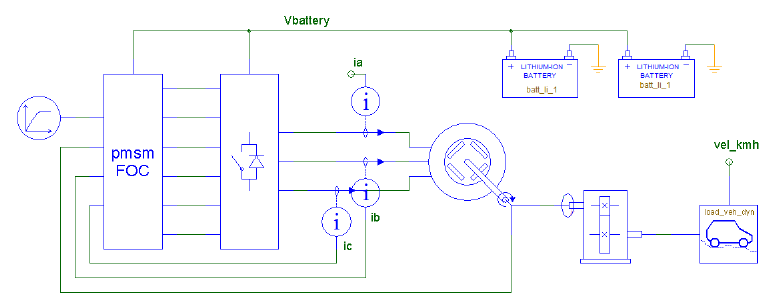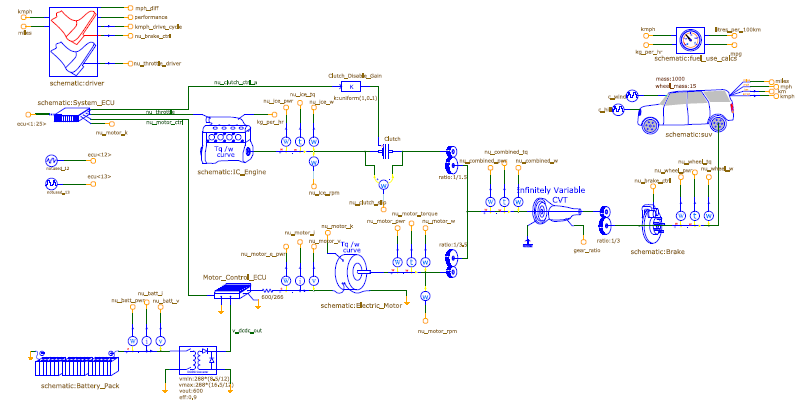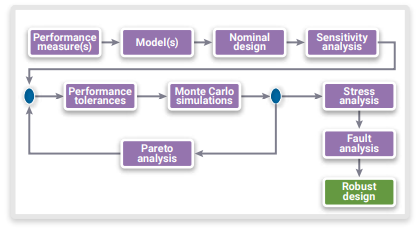Introduction
Consumer demand for higher fuel efficiency and decreased vehicle emissions has accelerated the development of pure electric (EV) and hybrid electric (HEV) drivetrains. Hybrid and Electric Vehicle (H/EV) development demand more and more accurate simulation of Automotive systems to achieve quality, reliability and cost-requirements. Moreover, reliable vehicle operation depends on successful integration and verification of all drivetrain component interactions under varying operational and environmental conditions. Given the extraordinary complex nature of hardware and software controls in drivetrain design, engineers use Robust Design methods to characterize and verify the interaction of mechatronic systems. Saber’s comprehensive modeling, simulation, and analysis capabilities are applied to improve system performance, reduce cost, and maximize reliability of these critical systems.
Saber: Hybrid and Electric Vehicle Feature Highlights:
SaberRD is used since many years in automotive field and obviously in H/EV design because this software
Analyzes power generation and distribution for motor drives and controls, regenerative braking, power assist, etc. Incorporates multi-domain effects at the system level – mechanical, electrical, thermal, and magnetics. Designs complex topologies, tests, and verifies control strategies, power management, torque/speed coupling, and vehicle dynamics. Optimizes cost, performance, and reliability with advanced stress, sensitivity, and statistical analyses. Specifies and sizes HEV and EV powertrains and components (motors, controllers, and energy management). Enhances system safety and reliability using Robust Design methodologies, Worst Case Analysis, and Fault Analysis with distributed grid computing.
EV Design:

A high fidelity PMSM motor model built by the JMAG FEA solver including spatial harmonics, flux saturation and frequency dependent iron losses is represented here. The motor is fed current by a 3-phase Voltage Source Inverter (VSI) controlled by an FOC algorithm implementing Maximum Torque per Amp (MTPA) and Flux Weakening strategies, and using the interceptive sinusoidal PWM method. The dc link voltage (365V) is realized by two Li-ion batteries in parallel. The motor shaft is connected to a single ratio gearbox (7.94), itself connected to a simplified car dynamics model accounting for the force of gravity on a sloped terrain.
HEV design:

This example is a high-level (low fidelity) HEV system design. The design contains hierarchical schematic models for typical hybrid electric vehicle designs, such as battery model, electric motor, internal combustion engine, transmission and ECUs, as well as hierarchical schematics for physical models, such as the brakes, vehicle mass and drag aspects. There are also driver inputs and a block that calculates fuel consumption and other interesting measurements (speed…).
Robust Design Methods used for H/EV
Improving vehicle safety and reliability requires a systematic development approach that ensures reliability issues are addressed as an integral part of the design process. Design teams use Robust Design methodologies to manage and optimize complex system interactions in response to operational and environmental variations. Saber’s Robust Design capability helps to improve design performance by incorporating manufacturing tolerance and variable operating conditions to a model. This makes the system immune to things like variations in design technologies, component parameters, manufacturing processes, etc.
To achieve this, Saber offers streamlined design flows for:
- Performance sensitivity to component variation.
- Monte Carlo and Pareto analyses for verifying uncorrelated manufacturing drift.
- Worse Case Analysis to identify critical operating points and perform multi-objective optimization.
- Stress Analysis to confirm operating ranges and component choices.
The objective is to find the most cost-effective design solution that meets performance, safety, and reliability specifications. Adopting a comprehensive simulation solution in conjunction with a Robust Design methodology ensures design teams can effectively analyze and verify complex drivetrain systems across a wide range of conditions.

Saber Components interaction
Saber Includes a huge library of models and modelling Tools for simulating HEV systems:- Motors and motor drives
- Power devices and drives – IGBTs, MOSFETs, BJTs
- Batteries, ultracapacitors, and charging systems
- Inverters, DC/DC converters, switches, speed controllers, capacitors
- Mechanical components
Hybrid and electric vehicles require characterized models to accurately simulate mechatronic system interactions. By having characterized models SaberRD ensures comprehensive simulation results that replace or reduce physical prototypes and testing. Moreover safe and reliable vehicle operation depends on the successful integration and verification of all drivetrain components. Integrating electrical, mechanical, and software disciplines together to create mechatronic systems becomes more challenging in hybrid and electric vehicles with the dramatic increase in switching and control systems. This increased complexity in mechatronic systems creates a greater challenge to produce reliable vehicles that meet stringent emissions, fuel economy, and performance criteria.
In conclusion
By using Saber, engineers who design H/EV will:- Improve the complete design by analyzing at the system, sub-system, or vehicle level
- Save time and eliminate errors by using models from an industry proven components library
- Optimize cost, performance, and reliability with advanced stress, sensitivity, and statistical analyses
- Model complete mechatronic systems using industry standard VHDL-AMS & MAST languages
- Test the complete system earlier with hardware/software co-simulation
- Increase analysis throughput with distributed simulations across multiple CPUs
EV and HEV depend on advanced electronically-controlled systems working together across a wide range of operating conditions to ensure efficient performance, safety and reliability. Increasing electrical content and complexity coupled with shorter design cycles require design teams to continually improve their design methods for mechatronic integration. To minimize risk and potential recall or re-design, engineers rely on simulation based on Robust Design methods to deliver predictable and reliable designs. Production proven, Saber is the leading solution for minimizing costs, reducing design iterations, and increasing vehicle reliability in today’s demanding design environment.


